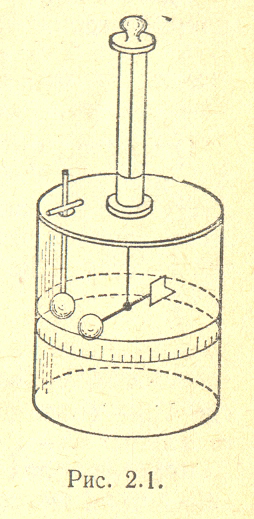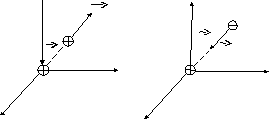
- •Ministry of Education and Science of Ukraine National Technical University of Ukraine "kpi"
- •1. Electrostatic field
- •1.1. Electrostatic field. Electric charge and its properties
- •1.5. Connection between intensity and potential.
- •§2. Description of the vector field
- •2.6. Stokes' theorem
- •§ 3. Stress Evaluation of Field according to Gauss' theorem
- •3.1. Impossibility of stable equilibrium of charge in an electric field
- •3.3 The field of two parallel charged planes
- •§4. Dielectric in external electric field
- •§5. Conductor in external electrostatic field
- •5.4. Connecting capacitors
- •§6. Energy of the electrostatic field
- •§7. Direct electric current and its characteristics.
- •§ 8. Classical electronic theory of electrical conductivity of metals
- •8.3. Ohm's law, Joule-Lenz, Wiedemann-Franz, their consideration on the basis of the theory of Drude-Lorentz
- •§10. Electric current in liquids
- •§11. Electric current in gases
1. Electrostatic field
1.1. Electrostatic field. Electric charge and its properties
Electrostatics - is the section of electrodynamics studying interaction of motionless electric charges. Such interaction is carried out through an electronic field.
Electric charge- is a physical quantity defining intensity of electromagnetic interactions. All elementary particles are characterized by the weight and the electric charge. The force of electromagnetic interactions is much bigger than their gravitational interaction. Value of force of electromagnetic interaction of particles is defined by their electric charges.
In total, four fundamental types of interaction exist in nature:
Strong;
Electromagnetic;
Weak;
Gravitational.
Each type of interaction is connected with a certain characteristic of a particle. For example, gravitational interaction depends on the weight of a particle, and electromagnetic interaction depends on its electric charge
Fundamental properties of electric charge:
Exists in two types- negative (electron) and positive (proton)
In any electrically isolated system the algebraic sum of charges doesn’t change. This property expresses charge conservation law:

Electric charge is rather invariant (its size doesn’t depend on a reference system, what not it moves or in the state of rest.
For simplification of mathematical calculations, the charge is considered to be non-discrete. Then it can be replaced with fictitious continuous distribution. In the process of transition to the continuous distribution the concept of density of a charge is introduced.
There are linear (λ,τ), surface (σ), and volumetric (ρ)density of charges:
Charge conservation law:
 ;
;
 ;
;
 .
.
Electric charges aren’t created and don’t disappear, but transferred from one body to another or redistributed inside this body.
Fractional charges in a free state don’t exist.
1.2. Coulomb’s law
The fundamental law of electrostatics is Coulomb’s law (1785). This law shows interaction of two motionless dot charges or charged bodies which sizes are small in comparison with distances between them. Coulomb studied interaction of charged bodies by means of tortional scales. He measured force of interaction of two charged balls depending on the size of charges on them and distance between them. Thus Coulomb relied on the fact that at a touch to the charged metal ball of the same not charged ball, the charge is distributed between both balls equally.
As a result
of lisexperiments, Coulomb came to the conclusion that: force
of interaction of two motionless dot charges is proportional to the
size of each charge and is inversely proportional to a distance
square.
The direction of force coincides with the straight line connecting charges. In the conditions of this interaction the similar charges repel, when opposite are attracted (fig.1.1.)
 ,
,
k - proportionality coefficient (depends on a choice of system of units)
fig.
1.1
 ,
,
where ε - dielectric permeability of the environment, ε0 - electrostatic invariable (ε0 = 8,85 • 10-12 F/m).
In system of SI unit of electric charge - C ("coulomb").
1 C - electric charge which passes for 1s through the cross section of the conductor at current 1A.
z z
F
Q2
Q2 r
r F
x x
Q1 Q1
y y
fig.1.2.
Thus, an electrostatic field - the special type of a matter connected with electric charges which transfers actions of charges from one to another. Electric field doesn't apear at interaction of charges. Any charge always has electric field. If the charge is motionless, that field is called electrostatic. It doesn't change in time and is created only by electric charges.
Electric field has specific physical properties. Electric charges of this field are affected by forces proportional to these charges. If it is necessary to reveal electric field, another charge is brought to the location of the charge is being used. For the determination of properties of a field,a trial single positive charge of Qpr, neglecting its own field. Force acts on Qpr:
 .
.
1.3. Intensity of electric field
If various charges are brought to the same point of a field, various forces will act on them, but the relation of forces to the size of a charge will remain constant for this point of a field:

For various points of a field it is possible to make similar ratios.
Force relation to the size of a trial charge is called as intensity of electric field. Intensity - the power characteristic of electric field; the relation of force to the size of trial charge:
 ,
,
r - distance from a charge of Q which creates a field to the field point where intensity is defined.
Intensity shows which force affects a single positive (trial) charge placed in this point of a field. Е - vector size; the direction of force is defined by the charge of Q affecting this point.
Tangential lines which in each point coincide with an intensity vector in this point of a field are called lines of intensity or power lines. Power lines can never be closed-loop on their own - they always have the beginning and the end or go to infinity. They are directed from a positive charge to negative (they leave a positive charge and enter negative). Lines of intensity are never crossed.

fig.1.3.
Electric field intensity which in all points is identical in size and in direction is called homogeneous (i.e. the charge is evenly distributed on the plane). The field of the flat condenser at some distance from edges of plates of the condenser can be an example of a homogeneous field.
The principle of superposition of fields (imposing of electric fields).
The
resultant force operating on Q charge from other charges of Q1> 0
and Q2 <0 will be equal to the geometrical sum of forces F1 and F2
from charges Q1 and Q2.
Q1>0 Q2<0
E2
Q E
E1
fig. 1.4

If the field is created by two charges, intensity is determined by the theorem of cosines:
 .
.
Generally speaking , if in a certain point of a field various charged particles create fields with intensities E1, E2, E3... En, the resultant intensity of a field in a point is:

1.4. Potential of electric field
Potential is the power characteristic of electric field; it shows which work is necessary to put to move a charge to this point of a field, or to transfer it from this point of a field to infinity. Potential characterizes potential energy which positive single charge would have in case it is of a field.
Work on movement doesn't depend on a form of a way, and depends only on placement of initial and final points of a trajectory. Work on movement of a charge which is performed in an electric chain on the closed contour equals to zero:
 .
.
When charges are moving, their relative positioning changes and therefore work of electric forces is equal to change of potential energy of a charge, which is moving:
 .
.
Potential energy of a charge in electric field is determined by a formula:
 .
.
Thus, potential φ

The formula is true, if φ → 0 at r → 0.
